Flood Frequency Analyses over Different Basin Scales in the Blue Nile River Basin, Ethiopia
Abstract
1. Introduction
2. Study Area
3. Methodology
3.1. Acquisition of Data on Flood Extremes
Annual Maximum Flow
3.2. Probability Distributions
3.3. Parameter Estimation Methods
3.4. Performance Measures
4. Results and Discussion
4.1. Application of the Probability Distribution Functions
4.2. Goodness of Fit Test Statistics
4.3. Discussion
5. Conclusions
Author Contributions
Funding
Acknowledgments
Conflicts of Interest
References
- Tegegne, G.; Kim, Y.-O. Modelling ungauged catchments using the catchment runoff response similarity. J. Hydrol. 2018, 564, 452–466. [Google Scholar] [CrossRef]
- Hailegeorgis, T.T.; Alfredsen, K. Regional flood frequency analysis and prediction in ungauged basins including estimation of major uncertainties for mid-Norway. J. Hydrol. Reg. Stud. 2017, 9, 104–126. [Google Scholar] [CrossRef]
- Tegegne, G.; Kim, Y.-O. Strategies to enhance the reliability of flow quantile prediction in the gauged and ungauged basins. River Res. Appl. 2020, 36, 724–734. [Google Scholar] [CrossRef]
- Tegegne, G.; Kim, Y.-O.; Seo, S.B.; Kim, Y. Hydrological modelling uncertainty analysis for different flow quantiles: A case study in two hydro-geographically different watersheds. Hydrol. Sci. J. 2019, 64, 473–489. [Google Scholar] [CrossRef]
- Ouarda, T.; Cunderlik, J.M.; St-Hilaire, A.; Barbet, M.; Bruneau, P.; Bobée, B. Data-based comparison of seasonality-based regional flood frequency methods. J. Hydrol. 2006, 330, 329–339. [Google Scholar] [CrossRef]
- Tegegne, G.; Park, D.K.; Kim, Y.-O. Comparison of hydrological models for the assessment of water resources in a data-scarce region, the Upper Blue Nile River Basin. J. Hydrol. Reg. Stud. 2017, 14, 49–66. [Google Scholar] [CrossRef]
- Chen, X.; Shao, Q.; Xu, C.-Y.; Zhang, J.; Zhang, L.; Ye, C. Comparative study on the selection criteria for fitting flood frequency distribution models with emphasis on upper-tail behavior. Water 2017, 9, 320. [Google Scholar] [CrossRef]
- Dong, Q.; Zhang, X.; Lall, U.; Sang, Y.-F.; Xie, P. An improved nonstationary model for flood frequency analysis and its implication for the Three Gorges Dam, China. Hydrol. Sci. J. 2019, 64, 845–855. [Google Scholar] [CrossRef]
- Engeland, K.; Wilson, D.; Borsányi, P.; Roald, L.; Holmqvist, E. Use of historical data in flood frequency analysis: A case study for four catchments in Norway. Hydrol. Res. 2018, 49, 466–486. [Google Scholar] [CrossRef]
- Gharib, A.; Davies, E.G.R.; Goss, G.G.; Faramarzi, M. Assessment of the combined effects of threshold selection and parameter estimation of Generalized Pareto Distribution with applications to flood frequency analysis. Water 2017, 9, 692. [Google Scholar] [CrossRef]
- Kim, S.U.; Son, M.; Chung, E.-S.; Yu, X. Effects of Non-Stationarity on Flood Frequency Analysis: Case Study of the Cheongmicheon Watershed in South Korea. Sustainability 2018, 10, 1329. [Google Scholar] [CrossRef]
- Langat, P.K.; Kumar, L.; Koech, R. Identification of the most suitable probability distribution models for maximum, minimum, and mean streamflow. Water 2019, 11, 734. [Google Scholar] [CrossRef]
- Rizwan, M.; Guo, S.; Xiong, F.; Yin, J. Evaluation of various probability distributions for deriving design flood featuring right-tail events in pakistan. Water 2018, 10, 1603. [Google Scholar] [CrossRef]
- Xiong, F.; Guo, S.; Chen, L.; Yin, J.; Liu, P. Flood frequency analysis using Halphen distribution and maximum entropy. J. Hydrol. Eng 2018, 23, 04018012. [Google Scholar] [CrossRef]
- Yu, G.; Wright, D.B.; Zhu, Z.; Smith, C.; Holman, K.D. Process-based flood frequency analysis in an agricultural watershed exhibiting nonstationary flood seasonality. Hydrol. Earth Syst. Sci. 2019, 23. [Google Scholar] [CrossRef]
- Tegegne, G.; Melesse, A.M. Multimodel Ensemble Projection of Hydro-climatic Extremes for Climate Change Impact Assessment on Water Resources. Water Resour. Manag. 2020, 1–17. [Google Scholar]
- Mallakpour, I.; Villarini, G. The changing nature of flooding across the central United States. Nat. Clim. Chang. 2015, 5, 250–254. [Google Scholar] [CrossRef]
- Vormoor, K.; Lawrence, D.; Schlichting, L.; Wilson, D.; Wong, W.K. Evidence for changes in the magnitude and frequency of observed rainfall vs. snowmelt driven floods in Norway. J. Hydrol. 2016, 538, 33–48. [Google Scholar] [CrossRef]
- Tegegne, G.; Kim, Y.-O. Representing Inflow Uncertainty for the Development of Monthly Reservoir Operations using Genetic Algorithms. J. Hydrol. 2020, 124876. [Google Scholar] [CrossRef]
- Shao, Q.; Wong, H.; Xia, J.; Ip, W.-C. Models for extremes using the extended three-parameter Burr XII system with application to flood frequency analysis/Modèles d’extrêmes utilisant le système Burr XII étendu à trois paramètres et application à l’analyse fréquentielle des crues. Hydrol. Sci. J. 2004, 49. [Google Scholar] [CrossRef]
- Stedinger, J.R.; Griffis, V.W. Flood Frequency Analysis in the United States: Time to Update; American Society of Civil Engineers: Reston, VA, USA, 2008. [Google Scholar]
- Salinas, J.L.; Castellarin, A.; Viglione, A.; Kohnova, S.; Kjeldsen, T.R. Regional parent flood frequency distributions in Europe-Part 1: Is the GEV model suitable as a pan-European parent? Hydrol. Earth Syst. Sci. 2014, 18, 4381. [Google Scholar] [CrossRef]
- Singh, V.P.; Strupczewski, W.G. On the status of flood frequency analysis. Hydrol. Process. 2002, 16, 3737–3740. [Google Scholar] [CrossRef]
- Hosking, J.R.M.; Wallis, J.R. Regional Frequency Analysis: An Approach Based on L-moments; Cambridge University Press: Cambridge, UK, 2005. [Google Scholar]
- Bačová-Mitková, V.; Onderka, M. Analysis of extreme hydrological events on the Danube using the peak over threshold method. J. Hydrol. Hydromech. 2010, 58, 88–101. [Google Scholar] [CrossRef]
- Basu, B.; Srinivas, V.V. Formulation of a mathematical approach to regional frequency analysis. Water Resour. Res. 2013, 49, 6810–6833. [Google Scholar] [CrossRef]
- Bezak, N.; Brilly, M.; Šraj, M. Comparison between the peaks-over-threshold method and the annual maximum method for flood frequency analysis. Hydrol. Sci. J. 2014, 59, 959–977. [Google Scholar] [CrossRef]
- Iacobellis, V.; Fiorentino, M.; Gioia, A.; Manfreda, S. Best fit and selection of theoretical flood frequency distributions based on different runoff generation mechanisms. Water 2010, 2, 239–256. [Google Scholar] [CrossRef]
- Ahilan, S.; Bruen, M.; O’Sullivan, J.J. Influences on flood frequency distributions in Irish river catchments. Hydrol. Earth Syst. Sci. (Hess) 2012, 16, 1137–1150. [Google Scholar] [CrossRef]
- Griffis, V.W.; Stedinger, J.R. Log-Pearson type 3 distribution and its application in flood frequency analysis. I: Distribution characteristics. J. Hydrol. Eng. 2007, 12, 482–491. [Google Scholar] [CrossRef]
- Houessou-Dossou, E.A.Y.; Mwangi Gathenya, J.; Njuguna, M.; Abiero Gariy, Z. Flood Frequency Analysis Using Participatory GIS and Rainfall Data for Two Stations in Narok Town, Kenya. Hydrology 2019, 6, 90. [Google Scholar] [CrossRef]
- Rahman, A.S.; Rahman, A.; Zaman, M.A.; Haddad, K.; Ahsan, A.; Imteaz, M. A study on selection of probability distributions for at-site flood frequency analysis in Australia. Nat. Hazards 2013, 69, 1803–1813. [Google Scholar] [CrossRef]
- Seckin, N.; Haktanir, T.; Yurtal, R. Flood frequency analysis of Turkey using L-moments method. Hydrol. Process. 2011, 25, 3499–3505. [Google Scholar] [CrossRef]
- Chowdhary, H.; Escobar, L.A.; Singh, V.P. Identification of suitable copulas for bivariate frequency analysis of flood peak and flood volume data. Hydrol. Res. 2011, 42, 193–216. [Google Scholar] [CrossRef]
- Dong, N.D.; Agilan, V.; Jayakumar, K.V. Bivariate flood frequency analysis of nonstationary flood characteristics. J. Hydrol. Eng. 2019, 24, 04019007. [Google Scholar] [CrossRef]
- Genest, C.; Favre, A.-C. Everything you always wanted to know about copula modeling but were afraid to ask. J. Hydrol. Eng. 2007, 12, 347–368. [Google Scholar] [CrossRef]
- Guo, A.; Chang, J.; Wang, Y.; Huang, Q.; Guo, Z.; Zhou, S. Bivariate frequency analysis of flood and extreme precipitation under changing environment: Case study in catchments of the Loess Plateau, China. Stoch. Environ. Res. Risk Assess. 2018, 32, 2057–2074. [Google Scholar] [CrossRef]
- Li, T.; Guo, S.; Liu, Z.; Xiong, L.; Yin, J. Bivariate design flood quantile selection using copulas. Hydrol. Res. 2017, 48, 997–1013. [Google Scholar] [CrossRef]
- Salvadori, G.; De Michele, C. Frequency analysis via copulas: Theoretical aspects and applications to hydrological events. Water Resour. Res. 2004, 40. [Google Scholar] [CrossRef]
- Zhang, L.; Singh, V.P. Bivariate flood frequency analysis using the copula method. J. Hydrol. Eng. 2006, 11, 150–164. [Google Scholar] [CrossRef]
- Zhang, L.; Singh, V.P. Trivariate flood frequency analysis using discharge time series with possible different lengths: Cuyahoga river case study. J. Hydrol. Eng. 2014, 19, 05014012. [Google Scholar] [CrossRef]
- Laio, F. Cramer–von Mises and Anderson-Darling goodness of fit tests for extreme value distributions with unknown parameters. Water Resour. Res. 2004, 40. [Google Scholar] [CrossRef]
- de Zea Bermudez, P.; Kotz, S. Parameter estimation of the generalized Pareto distribution—Part I. J. Stat. Plan. Inference 2010, 140, 1353–1373. [Google Scholar] [CrossRef]
- Strupczewski, W.G.; Singh, V.P.; Feluch, W. Non-stationary approach to at-site flood frequency modelling I. Maximum likelihood estimation. J. Hydrol. 2001, 248, 123–142. [Google Scholar] [CrossRef]
- Greenwood, J.A.; Landwehr, J.M.; Matalas, N.C.; Wallis, J.R. Probability weighted moments: Definition and relation to parameters of several distributions expressable in inverse form. Water Resour. Res. 1979, 15, 1049–1054. [Google Scholar] [CrossRef]
- Viglione, A.; Laio, F.; Claps, P. A comparison of homogeneity tests for regional frequency analysis. Water Resour. Res. 2007, 43. [Google Scholar] [CrossRef]
- Kysely, J.; Picek, J. Regional growth curves and improved design value estimates of extreme precipitation events in the Czech Republic. Clim. Res. 2007, 33, 243–255. [Google Scholar] [CrossRef]
- Elamir, E.A.H.; Seheult, A.H. Trimmed L-moments. Comput. Stat. Data Anal. 2003, 43, 299–314. [Google Scholar] [CrossRef]
- Zhang, J. Likelihood moment estimation for the generalized Pareto distribution. Aust. N. Z. J. Stat. 2007, 49, 69–77. [Google Scholar] [CrossRef]
- Molina-Aguilar, J.P.; Gutierrez-Lopez, A.; Raynal-Villaseñor, J.A.; Garcia-Valenzuela, L.G. Optimization of Parameters in the Generalized Extreme-Value Distribution Type 1 for Three Populations Using Harmonic Search. Atmosphere 2019, 10, 257. [Google Scholar] [CrossRef]
- Singh, V.P.; Singh, K. Parameter estimation for log-Pearson type III distribution by POME. J. Hydraul. Eng. 1988, 114, 112–122. [Google Scholar] [CrossRef]
- Singh, V.P.; Guo, H. Parameter estimation for 3-parameter generalized Pareto distribution by the principle of maximum entropy (POME). Hydrol. Sci. J. 1995, 40, 165–181. [Google Scholar] [CrossRef]
- Singh, V.P. Hydrologic synthesis using entropy theory. J. Hydrol. Eng. 2011, 16, 421–433. [Google Scholar] [CrossRef]
- Bobee, B.; Ashkar, F. The Gamma Family and Derived Distributions Applied Inhydrology/Bernard, Bobee and Fahim Ashkar; Water Resources Publications: Littleton, CO, USA, 1991. [Google Scholar]
- Committee, W.R.C.H. Guidelines for Determining Flood Flow Frequency; US Water Resources Council: Reston, VA, USA, 1981; Volume 17. [Google Scholar]
- Haan, C.T. Statistical Methods in Hydrology; The Iowa State University Press: Iowa, IA, USA, 1977. [Google Scholar]
- Gumbel, E.J. Statistics of Extremes; Courier Corporation: Mineola, NY, USA, 2012. [Google Scholar]
- Pickands Iii, J. Statistical inference using extreme order statistics. Ann. Stat. 1975, 3, 119–131. [Google Scholar]
- Hosking, J.R.M.; Wallis, J.R. Parameter and quantile estimation for the generalized Pareto distribution. Technometrics 1987, 29, 339–349. [Google Scholar] [CrossRef]
- Haddad, K.; Rahman, A.; Stedinger, J.R. Regional flood frequency analysis using Bayesian generalized least squares: A comparison between quantile and parameter regression techniques. Hydrol. Process. 2012, 26, 1008–1021. [Google Scholar] [CrossRef]

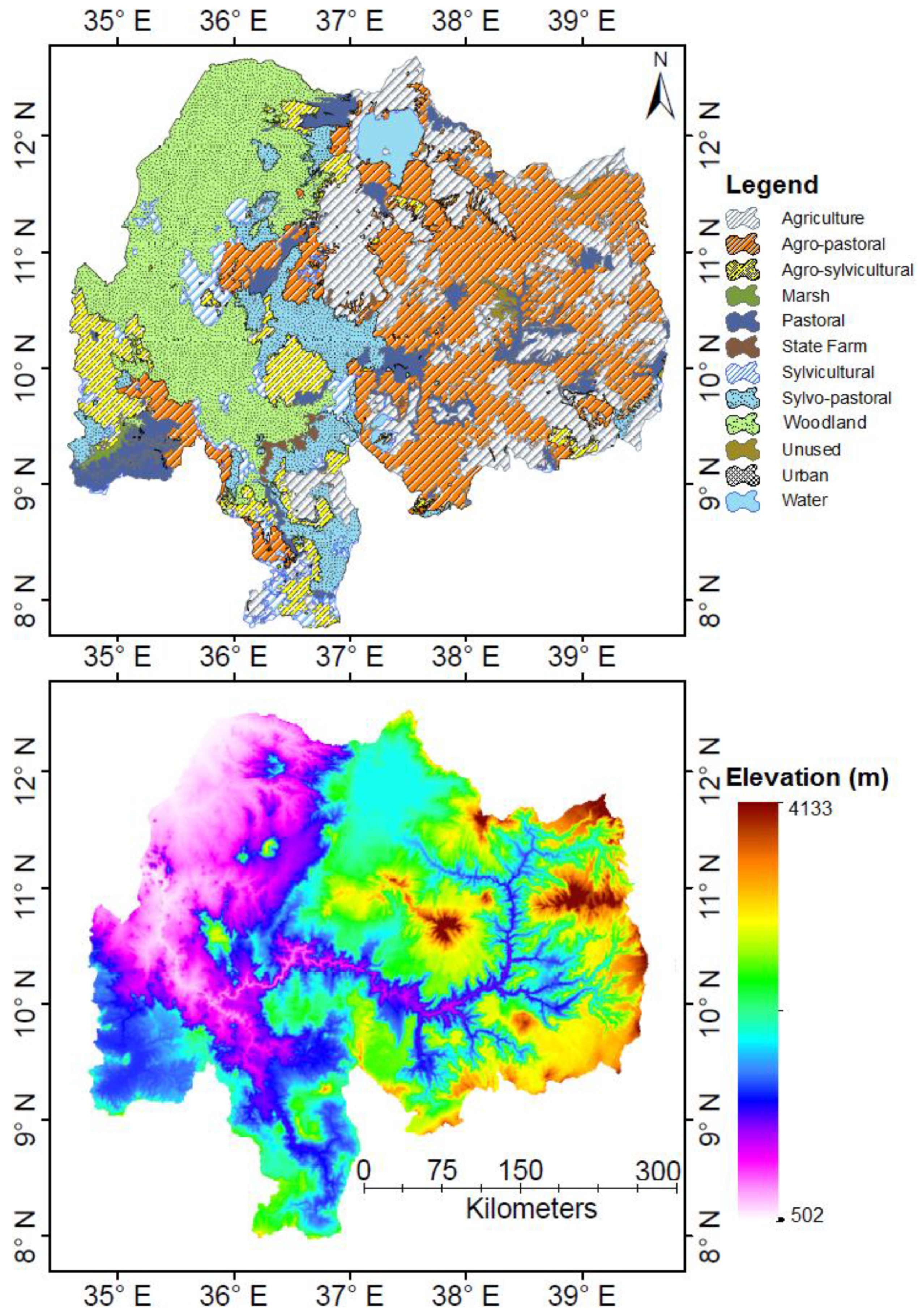
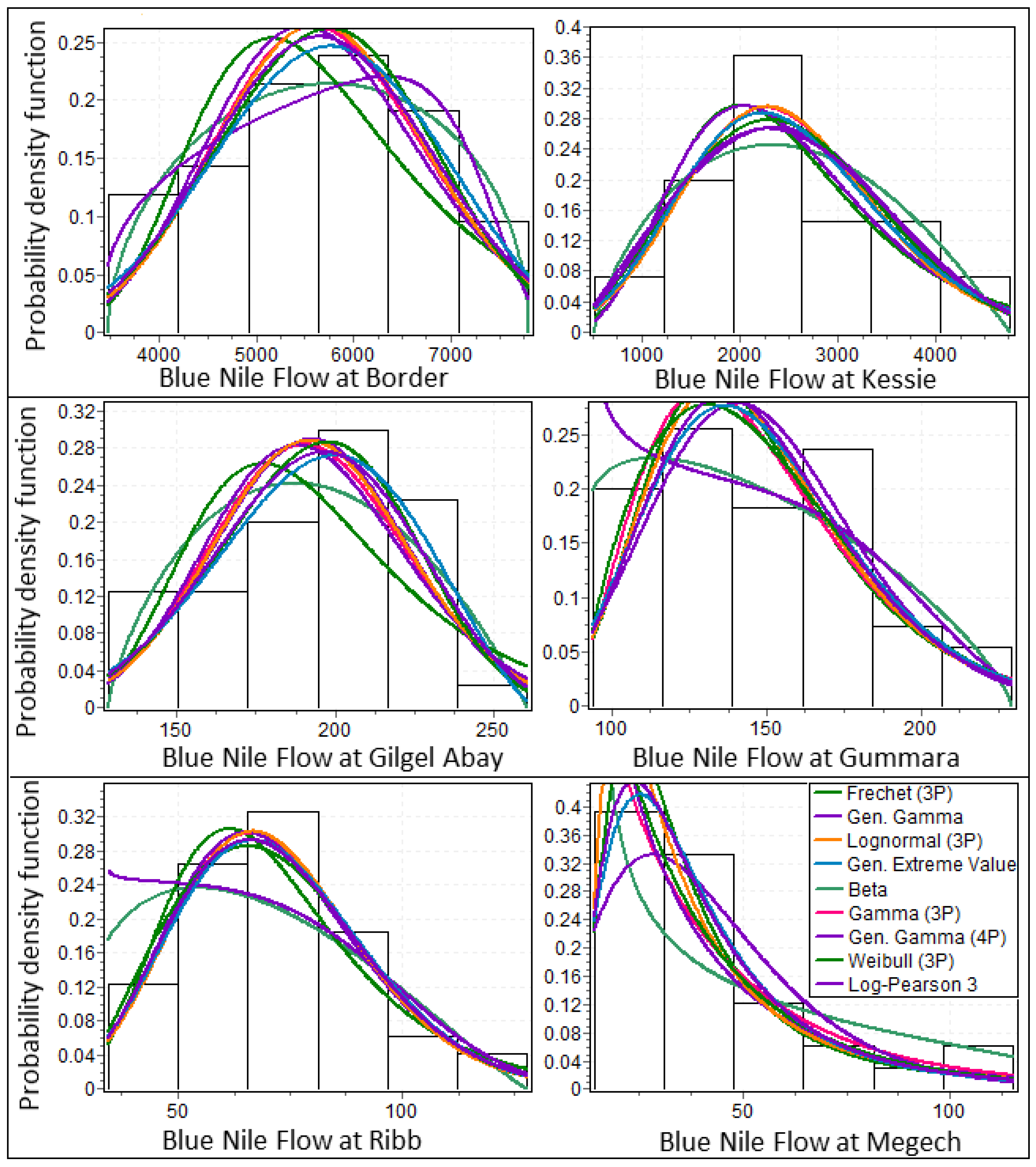
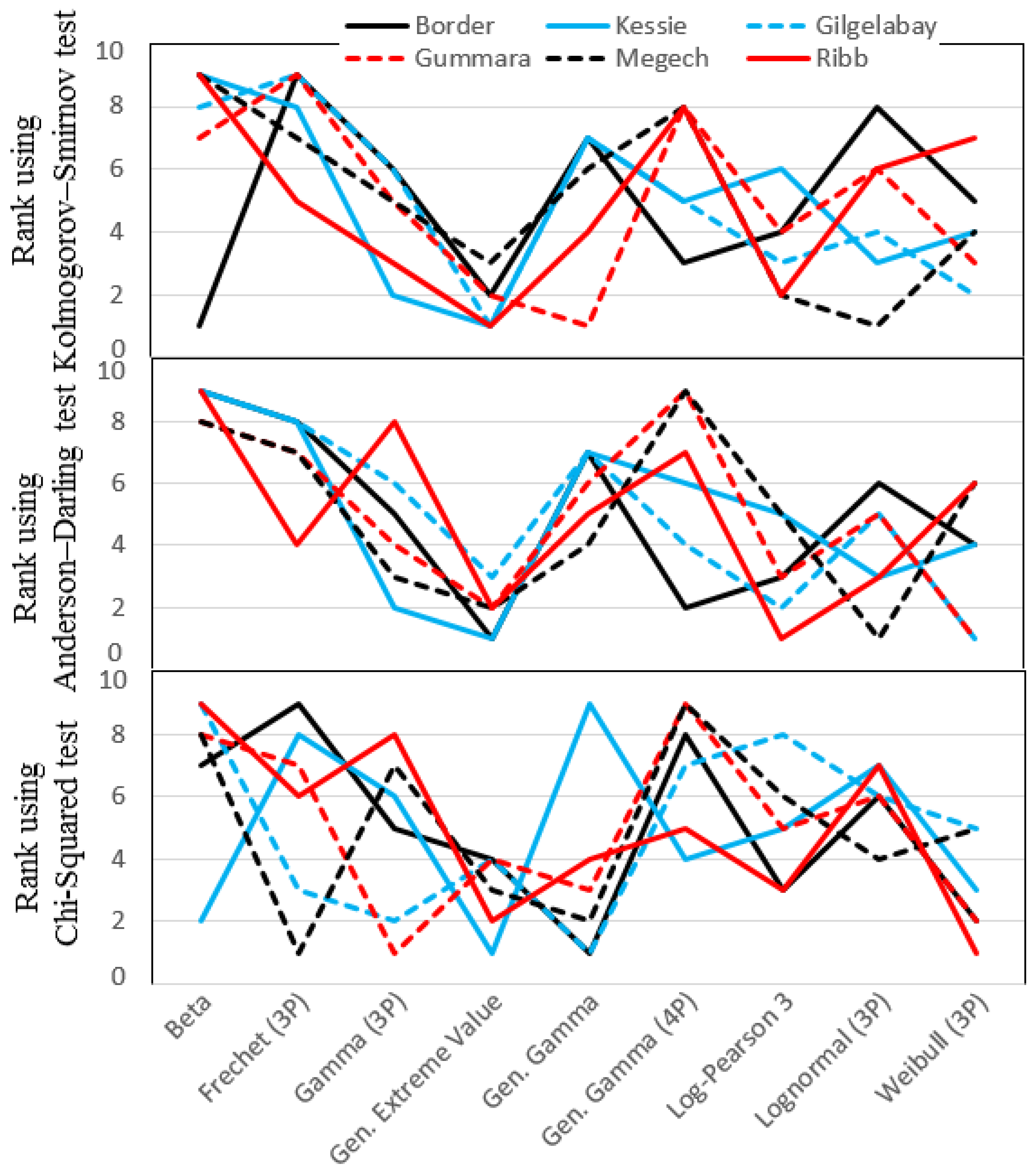
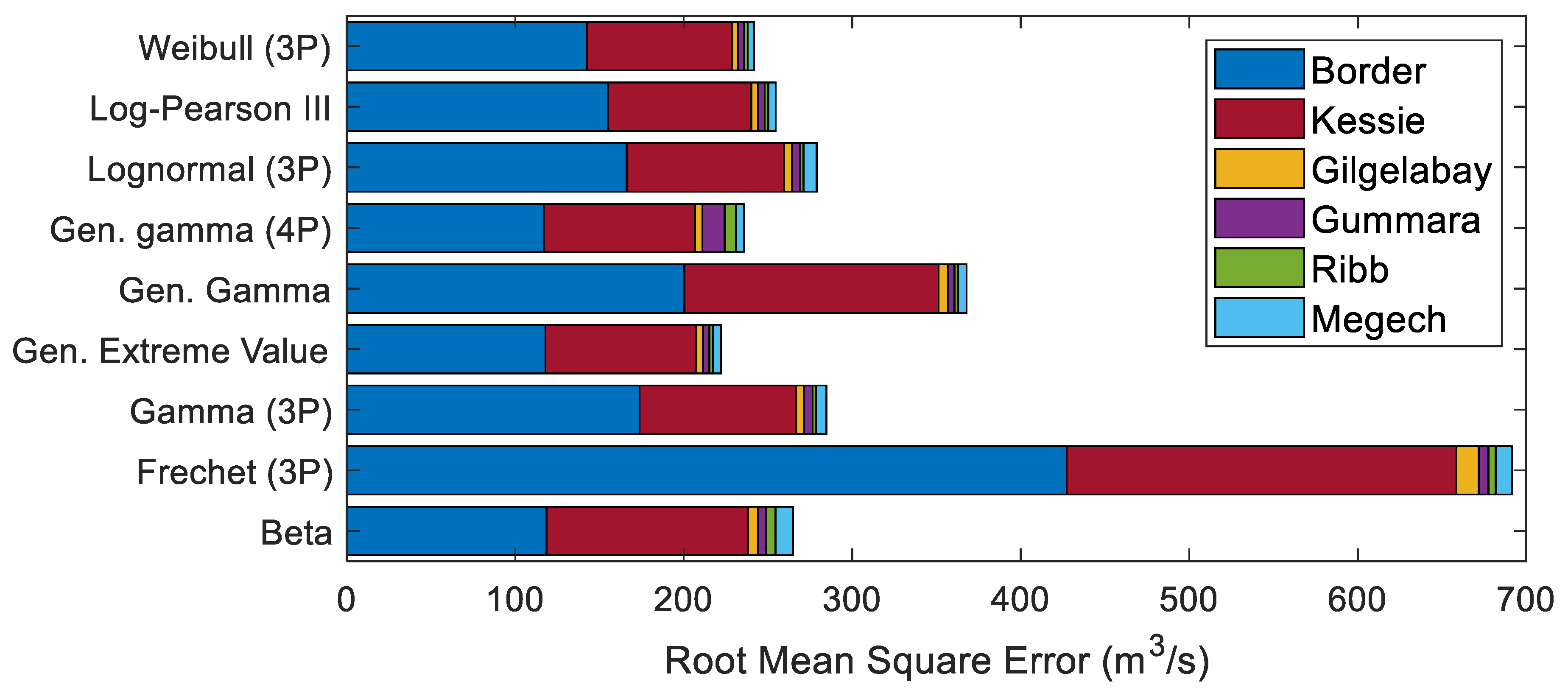
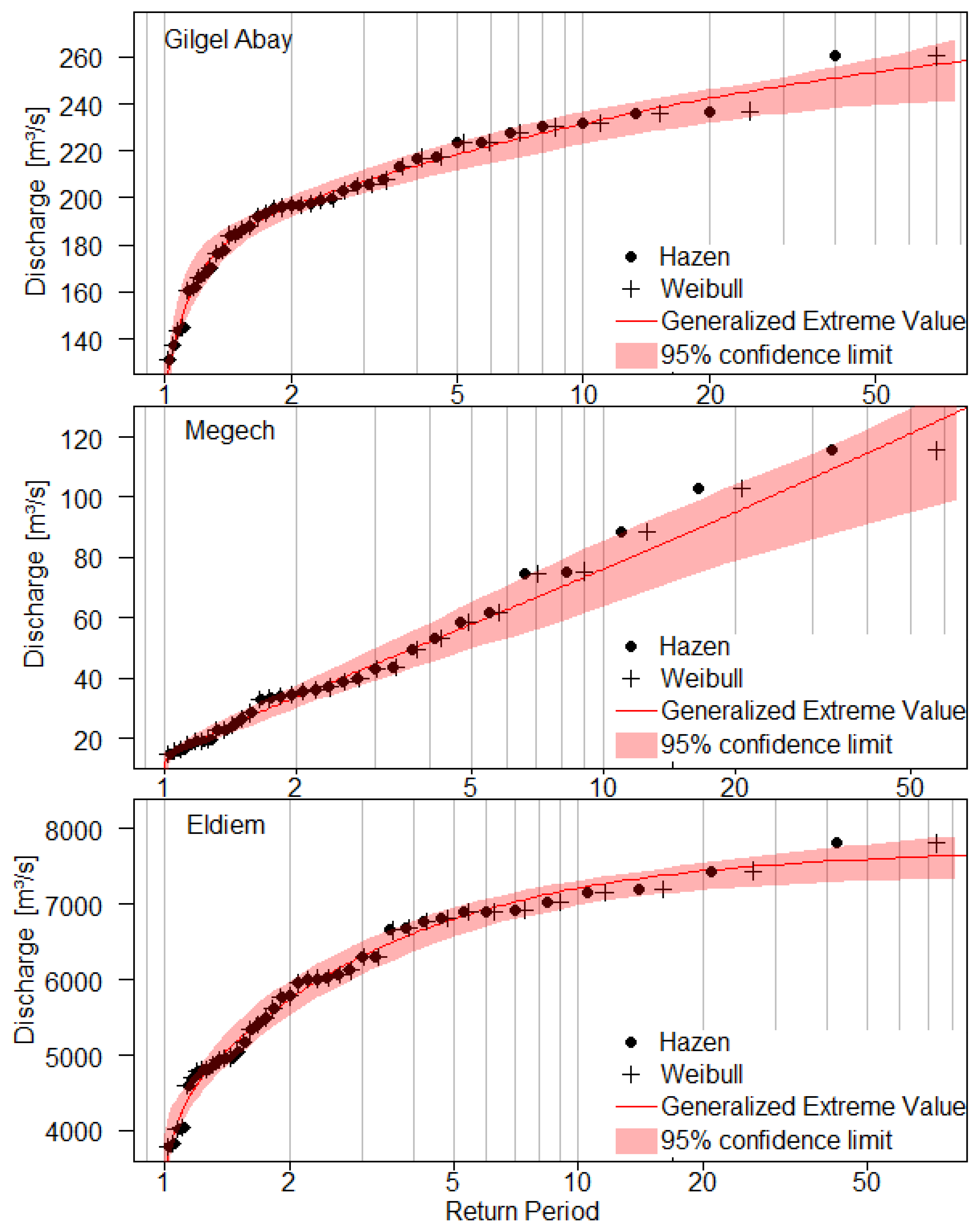

| Megech (1980–2012) | Ribb (1965–2013) | Gummara (1959–2013) | Gilgel Abay (1973–2012) | Kessie (1960–2014) | Eldiem (1961–2002) | |
|---|---|---|---|---|---|---|
| Mean. | 40.93 | 71.55 | 147.88 | 192.91 | 2471.34 | 5694.92 |
| Standard Error | 4.48 | 3.05 | 4.55 | 4.88 | 133.00 | 168.94 |
| Median | 34.61 | 70.82 | 142.07 | 196.33 | 2360.25 | 5769.50 |
| Standard Deviation | 25.73 | 21.32 | 33.77 | 30.84 | 986.39 | 1094.84 |
| Kurtosis | 1.60 | 0.26 | −0.44 | −0.19 | −0.36 | −0.80 |
| Skewness | 1.41 | 0.43 | 0.48 | −0.27 | 0.30 | −0.13 |
| Range | 101.71 | 93.27 | 135.90 | 131.82 | 4257.44 | 4324.96 |
| Minimum | 13.82 | 34.53 | 93.55 | 128.53 | 506.25 | 3475.07 |
| Maximum | 115.53 | 127.79 | 229.45 | 260.35 | 4763.69 | 7800.03 |
| Distribution | Probability Density Function | Bound |
|---|---|---|
| EV2 | ||
| GM3P | ||
| GMG4P | ||
| GEV | ||
| BT | ||
| LP3 | ||
| LN | ||
| WB3P |
© 2020 by the authors. Licensee MDPI, Basel, Switzerland. This article is an open access article distributed under the terms and conditions of the Creative Commons Attribution (CC BY) license (http://creativecommons.org/licenses/by/4.0/).
Share and Cite
Tegegne, G.; Melesse, A.M.; Asfaw, D.H.; Worqlul, A.W. Flood Frequency Analyses over Different Basin Scales in the Blue Nile River Basin, Ethiopia. Hydrology 2020, 7, 44. https://doi.org/10.3390/hydrology7030044
Tegegne G, Melesse AM, Asfaw DH, Worqlul AW. Flood Frequency Analyses over Different Basin Scales in the Blue Nile River Basin, Ethiopia. Hydrology. 2020; 7(3):44. https://doi.org/10.3390/hydrology7030044
Chicago/Turabian StyleTegegne, Getachew, Assefa M. Melesse, Dereje H. Asfaw, and Abeyou W. Worqlul. 2020. "Flood Frequency Analyses over Different Basin Scales in the Blue Nile River Basin, Ethiopia" Hydrology 7, no. 3: 44. https://doi.org/10.3390/hydrology7030044
APA StyleTegegne, G., Melesse, A. M., Asfaw, D. H., & Worqlul, A. W. (2020). Flood Frequency Analyses over Different Basin Scales in the Blue Nile River Basin, Ethiopia. Hydrology, 7(3), 44. https://doi.org/10.3390/hydrology7030044






